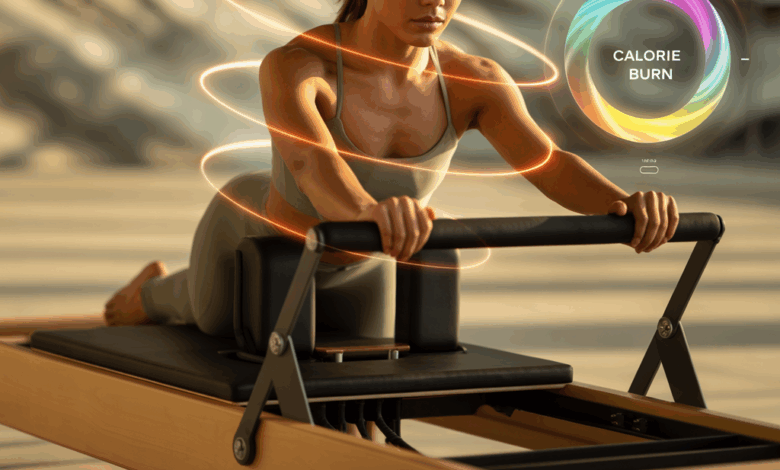How Many Calories Does Pilates Reformer Burn? Realistic Estimates & Ways to Maximize Results

Have you ever finished a 50-minute Pilates Reformer class, sweat-drenched and exhilarated, and wondered, “So how many calories does pilates reformer burn?” You’re not alone — it’s one of the first questions people ask when they want to justify time and effort. The short answer? It depends. The long answer? Read on for realistic calorie estimates, factors that influence burn, workout variations, and practical tips to get more from every session.
Why calorie burn from reformer Pilates varies so much
Reformer workouts range from slow, controlled sessions focused on alignment and mobility to fast-paced, resistance-heavy classes that feel closer to strength training. Variables that influence calories burned include your weight, age, sex, fitness level, workout intensity, class length, and even instructor style. Unlike steady-state cardio, Pilates combines balance, core work, and resistance, so calorie totals can swing widely.
How many calories does pilates reformer burn: realistic estimates
Here are practical, evidence-based estimates to give you a ballpark number. For a 60-minute session:
- Light / restorative reformer class: ~180–260 calories per hour
- Moderate intensity (most studio classes): ~250–400 calories per hour
- Vigorous, athletic reformer (power or HIIT-style): ~400–550+ calories per hour
Examples by bodyweight for a 60-minute workout (approximate):
- 125 lb person: 200–350 calories
- 155 lb person: 250–420 calories
- 185 lb person: 300–500 calories
Shorter sessions scale down proportionally — a 45-minute vigorous reformer could still burn 300–375 calories, for instance. These are estimates; individual variation is normal.
Factors that control calorie burn
Workout intensity and pace
Faster transitions, more springs/tension, and full-body compound movements raise heart rate and energy expenditure. A power reformer class that keeps you moving will burn significantly more than a slow, mobility-focused session.
Resistance and springs
More resistance forces your muscles to work harder, increasing metabolic demand and calories burned. That’s why experienced clients often get more out of the same class — they can handle heavier springs and higher load.
Session length and weekly frequency
Duration matters, but so does consistency. Three 45–60 minute reformer sessions per week will have a much bigger metabolic impact than one long session.
Workout variations to increase calorie burn
- HIIT Reformer: Alternate 30–60 seconds of high-effort compound moves (jumpboard, quick lunges) with 30–60 seconds recovery.
- Strength-focused: Use heavier springs, slow eccentric loading and include multiple sets to build muscle — muscle increases resting metabolic rate.
- Power flow: Faster tempo, minimal rest, full-body transitions to keep heart rate elevated.
- Hybrid sessions: Combine 20 minutes of cardio (bike, row) with a 30–40 minute reformer strength set.
Practical tips to maximize calorie burn on the reformer
- Progressive overload: Gradually increase springs or reps over weeks to challenge your muscles.
- Engage the whole body: Choose exercises that link arms, legs, and core (e.g., lunges with arm work).
- Minimize downtime: Keep transitions efficient; a well-structured class with purposeful rest boosts overall caloric output.
- Mix modalities: Add 1–2 cardio sessions weekly to accelerate fat loss and cardiovascular fitness.
- Fuel and recover: Eat a balanced mix of protein and carbs around workouts and prioritize sleep for recovery and metabolic health.
Real-world example: A week of reformer training
Meet Emma, 34, 150 lb, wants to lose fat and build tone. Her plan:
- Monday: 50-minute power reformer class (~350 calories)
- Wednesday: 45-minute moderate reformer + 20-minute brisk walk (~300 calories total)
- Friday: 30-minute HIIT reformer (~250 calories)
- Weekend: 30–45 minute active recovery — yoga or long walk
Over a week, Emma burns an extra ~900–1200 calories from formal sessions, plus increased resting metabolism from added muscle — a realistic, sustainable path to body recomposition.
Nutrition and lifestyle tips to amplify results
- Prioritize protein: Aim for 20–30 g per meal to support muscle repair after reformer sessions.
- Hydrate and time carbs: A small carb-rich snack before high-intensity sessions can improve performance; carbs after help recovery.
- Sleep: 7–9 hours per night supports hormones that regulate appetite and recovery.
- Track progress by strength and how clothes fit, not just the scale — Pilates often improves posture, tone, and function before large weight changes appear.
Frequently Asked Questions
Smartwatch estimates can help track trends but are often imprecise for resistance-based workouts. They may under- or overestimate burn because algorithms favor steady-state cardio. Use them as a guide, not gospel.
Yes, you can lose weight with consistent reformer training combined with a sensible diet and sufficient activity. For faster results, add cardio and prioritize progressive overload and nutrition.
Reformer Pilates builds muscular strength, endurance, and neuromuscular control. With progressive resistance and enough volume, you can build noticeable muscle and improve metabolic rate.
Conclusion: So, how many calories does pilates reformer burn?
Reformer Pilates can burn anywhere from ~180 to 550+ calories per hour depending on intensity, resistance, and your body. It’s a flexible tool — great for mobility, core strength, and when programmed with progressive overload and higher-intensity flows, it can be a strong calorie-burning, muscle-building modality. If your goal is weight loss or improved fitness, combine regular reformer sessions with targeted nutrition, cross-training, and consistent recovery.
Ready to turn your reformer sessions into measurable progress? Try a mix of power and HIIT-style classes this week, track how you feel, and pair that with a structured eating plan. For workout templates and weekly plans, check our workout routines. Need help dialing in your meals? Visit our nutrition guides. For recovery and habit advice, browse our wellness tips.
Want a personalized plan to maximize your calorie burn on the reformer? Book a consultation with a certified instructor or try a 4-week progressive program focused on strength and intensity — consistency is where results come from.





